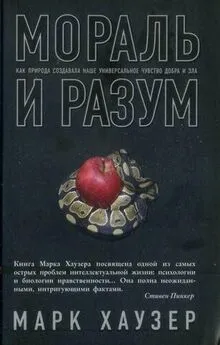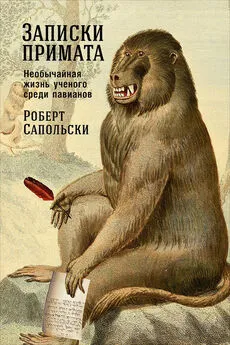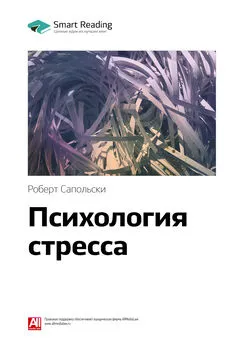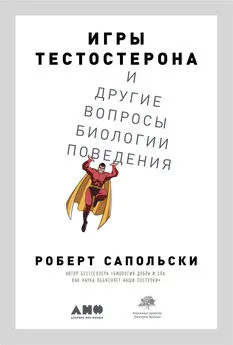Роберт Сапольски - Биология добра и зла. Как наука объясняет наши поступки
- Название:Биология добра и зла. Как наука объясняет наши поступки
- Автор:
- Жанр:
- Издательство:Альпина нон-фикшн
- Год:2019
- Город:Москва
- ISBN:978-5-0013-9051-0
- Рейтинг:
- Избранное:Добавить в избранное
-
Отзывы:
-
Ваша оценка:
Роберт Сапольски - Биология добра и зла. Как наука объясняет наши поступки краткое содержание
Биология добра и зла. Как наука объясняет наши поступки - читать онлайн бесплатно ознакомительный отрывок
Интервал:
Закладка:
69
W. Seeley et al., “Early Frontotemporal Dementia Targets Neurons Unique to Apes and Humans,” Annals of Neurol 60 (2006): 660; R. Levenson and B. Miller, “Loss of Cells, Loss of Self: Frontotemporal Lobar Degeneration and Human Emotion,” Curr Dir Psych Sci 16 (2008): 289.
70
U. Voss et al., “Induction of Self Awareness in Dreams Through Frontal Low Curr Stimulation of Gamma Activity,” Nat Nsci 17 (2014): 810; J. Georgiadis et al., “Regional Cerebral Blood Flow Changes Associated with Clitorally Induced Orgasm in Healthy Women,” Eur J Nsci 24 (2006): 3305.
71
A. Glenn et al., “Antisocial Personality Disorder: A Current Review,” Curr Psychiatry Rep 15 (2013): 427; N. Anderson and K. Kiehl, “The Psychopath Magnetized: Insights from Brain Imaging,” TICS 16 (2012): 52; L. Mansnerus, “Damaged Brains and the Death Penalty,” New York Times , July 21, 2001, p. B9; M. Brower and B. Price, “Neuropsychiatry of Frontal Lobe Dysfunction in Violent and Criminal Behaviour: A Critical Review,” J Neurol, Neurosurgery & Psychiatry 71 (2001): 720.
72
J. Greene et al., “The Neural Bases of Cognitive Conflict and Control in Moral Judgment,” Neuron 44 (2004): 389; S. McClure et al., “Separate Neural Systems Value Immediate and Delayed Monetary Rewards,” Sci 306 (2004): 503.
73
A. Barbey et al., “Dorsolateral Prefrontal Contributions to Human Intelligence,” Neuropsychologia 51 (2013): 1361.
74
D. Knock et al., “Diminishing Reciprocal Fairness by Disrupting the Right Prefrontal Cortex,” Sci 314(2006): 829.
75
D. Mobbs et al., “A Key Role for Similarity in Vicarious Reward,” Sci 324 (2009): 900; P. Janata et al., “The Cortical Topography of Tonal Structures Underlying Western Music,” Sci 298 (2002): 2167; M. Balter, “Study of Music and the Mind Hits a High Note in Montreal,” Sci 315 (2007): 758.
76
J. Saver and A. Damasio, “Preserved Access and Processing of Social Knowledge in a Patient with Acquired Sociopathy Due to Ventromedial Frontal Damage,” Neuropsychologia 29 (1991): 1241; M. Donoso et al., “Foundations of Human Reasoning in the Prefrontal Cortex,” Sci 344 (2014): 1481; T. Hare, “Exploiting and Exploring the Options,” Sci 344 (2014): 1446; T. Baumgartner et al., “Dorsolateral and Ventromedial Prefrontal Cortex Orchestrate Normative Choice,” Nat Nsci 14 (2011): 1468; A. Bechara, “The Role of Emotion in Decision-Making: Evidence from Neurological Patients with Orbitofrontal Damage,” Brain and Cog 55 (2004): 30.
77
A. Damasio, The Feeling of What Happens: Body and Emotion in the Making of Consciousness (Boston: Harcourt, 1999).
78
M. Koenigs et al., “Damage to the Prefrontal Cortex Increases Utilitarian Moral Judgments,” Nat 446 (2007): 865; B. Thomas et al., “Harming Kin to Save Strangers: Further Evidence for Abnormally Utilitarian Moral Judgments After Ventromedial Prefrontal Damage,” J Cog Nsci 23 (2011): 2186.
79
A. Bechara et al., “Deciding Advantageously Before Knowing the Advantageous Strategy,” Sci 275 (1997): 1293; A. Bechara et al., “Insensitivity to Future Consequences Following Damage to Human Prefrontal Cortex,” Cog 50 (1994): 7.
80
L. Young et al., “Damage to Ventromedial Prefrontal Cortex Impairs Judgment of Harmful Intent,” Neuron 25 (2010): 845.
81
C. Limb and A. Braun, “Neural Substrates of Spontaneous Musical Performance: An fMRI Study of Jazz Improvisation,” PLoS ONE 3 (2008): e1679; C. Salzman and S. Fusi, “Emotion, Cognition, and Mental State Representation in Amygdala and Prefrontal Cortex,” Ann Rev of Nsci 33 (2010): 173.
82
J. Greene et al., “An fMRI Investigation of Emotional Engagement in Moral Judgment,” Sci 293 (2001): 2105; J. Greene et al., “The Neural Bases of Cognitive Conflict and Control in Moral Judgment,” Neuron 44 (2004): 389–400; J. Greene, Moral Tribes: Emotion, Reason, and the Gap Between Us and Them (New York: Penguin, 2013).
83
J. Peters et al., “Induction of Fear Extinction with Hippocampal-Infralimbic BDNF,” Sci 328 (2010): 1288; M. Milad and G. Quirk, “Neurons in Medial Prefrontal Cortex Signal Memory for Fear Extinction,” Nat 420 (2002): 70; M. Milad and G. Quirk, “Fear Extinction as a Model for Translational Neuroscience: Ten Years of Progress,” Ann Rev of Psych 63 (2012): 129; C. Lai et al., “Opposite Effects of Fear Conditioning and Extinction on Dendritic Spine Remodeling,” Nat 483 (2012): 87. Некоторые из недавних работ предполагают включение обоих участков – и вмПФК, и базолатеральной миндалины: A. Adhikari et al., “Basomedial Amygdala Mediates Top-Down Control of Anxiety and Fear,” Nat 527 (2016): 179.
84
K. Ochsner et al., “Rethinking Feelings: An fMRI Study of the Cognitive Regulation of Emotion,” J Cog Nsci 14 (2002): 1215; G. Sheppes and J. Gross, “Is Timing Everything? Temporal Considerations in Emotion Regulation,” PSPR 15 (2011): 319; G. Sheppes and Z. Levin, “Emotion Regulation Choice: Selecting Between Cognitive Regulation Strategies to Control Emotion,” Front Human Neurosci 7 (2013): 179; J. Gross, “Antecedent- and Response-Focused Emotion Regulation: Divergent Consequences for Experience, Expression, and Physiology,” JPSP 74 (1998): 224; J. Gross, “Emotion Regulation: Affective, Cognitive, and Social Consequences,” Psychophysiology 39 (2002): 281; K. Ochsner and J. Gross, “The Cognitive Control of Emotion,” TICS 9 (2005): 242.
85
M. Lieberman et al., “The Neural Correlates of Placebo Effects: A Disruption Account,” NeuroImage 22 (2004): 447; P. Petrovic et al., “Placebo and Opioid Analgesia: Imaging a Shared Neuronal Network,” Sci 295 (2002): 1737.
86
J. Beck, Cognitive Behavior Therapy , 2nd edition (New York: Guilford Press, 2011); P. Goldin et al., “Cognitive Reappraisal Self-Efficacy Mediates the Effects of Individual Cognitive-Behavioral Therapy for Social Anxiety Disorder,” J Consulting Clin Psych 80 (2012): 1034.
87
A. Bechara et al., “Failure to Respond Autonomically to Anticipated Future Outcomes Following Damage to Prefrontal Cortex,” Cerebral Cortex 6 (1996): 215; C. Martin et al., “The Effects of Vagus Nerve Stimulation on Decision-Making,” Cortex 40 (2004): 605.
88
G. Bodenhausen et al., “Negative Affect and Social Judgment: The Differential Impact of Anger and Sadness,” Eur J Soc Psych 24 (1994): 45; A. Sanfey et al., “The Neural Basis of Economic Decision-Making in the Ultimatum Game,” Sci 300 (2003): 1755; K. Gospic et al., “Limbic Justice: Amygdala Involvement in Immediate Rejections in the Ultimatum Game,” PLoS ONE 9 (2011): e1001054.
89
D. Wegner, “How to Think, Say, or Do Precisely the Worst Thing on Any Occasion,” Sci 325 (2009): 58.
90
R. Davidson and S. Begley, The Emotional Life of Your Brain (New York: Hudson Street Press, 2011); A. Tomarken and R. Davidson, “Frontal Brain Activation in Repressors and Nonrepressors,” J Abnormal Psych 103 (1994): 339.
91
A. Ito et al., “The Contribution of the Dorsolateral Prefrontal Cortex to the Preparation for Deception and Truth-Telling,” Brain Res 1464 (2012): 43; S. Spence et al., “A Cognitive Neurobiological Account of Deception: Evidence from Functional Neuroimaging,” Philosophical Transactions of the Royal Soc London Series B 359 (2004): 1755; I. Karton and T. Bachmann, “Effect of Prefrontal Transcranial Magnetic Stimulation on Spontaneous Truth-Telling,” BBR 225 (2011): 209; Y. Yang et al., “Prefrontal White Matter in Pathological Liars,” Brit J Psychiatry 187 (2005): 320.
92
D. Carr and S. Sesack, “Projections from the Rat Prefrontal Cortex to the Ventral Tegmental Area: Target Specificity in the Synaptic Associations with Mesoaccumbens and Mesocortical Neurons,” J Nsci 20 (2000): 3864; M. Stefani and B. Moghaddam, “Rule Learning and Reward Contingency Are Associated with Dissociable Patterns of Dopamine Activation in the Rat Prefrontal Cortex, Nucleus Accumbens, and Dorsal Striatum,” J Nsci 26 (2006): 8810.
93
T. Danjo et al., “Aversive Behavior Induced by Optogenetic Inactivation of Ventral Tegmental Area Dopamine Neurons Is Mediated by Dopamine D2 Receptors in the Nucleus Accumbens,” PNAS 111 (2014): 6455; N. Schwartz et al., “Decreased Motivation During Chronic Pain Requires Long-Term Depression in the Nucleus Accumbens,” Nat 345 (2014): 535.
94
J. Cloutier et al., “Are Attractive People Rewarding? Sex Differences in the Neural Substrates of Facial Attractiveness,” J Cog Nsci 20 (2008): 941; K. Demos et al., “Dietary Restraint Violations Influence Reward Responses in Nucleus Accumbens and Amygdala,” J Cog Nsci 23 (2011): 1952.
95
Сноска: R. Deaner et al., “Monkeys Pay per View: Adaptive Valuation of Social Images by Rhesus Macaques,” Curr Biol 15 (2005): 543.
96
V. Salimpoor et al., “Interactions Between the Nucleus Accumbens and Auditory Cortices Predicts Music Reward Value,” Sci 340 (2013): 216; G. Berns and S. Moore, “A Neural Predictor of Cultural Popularity,” J Consumer Psych 22 (2012): 154; S. Erk et al., “Cultural Objects Modulate Reward Circuitry,” Neuroreport 13 (2002): 2499.
97
A. Sanfey et al., “The Neural Basis of Economic Decision-Making in the Ultimatum Game,” Sci 300 (2003): 1755. Также см. работы: J. Moll et al., “Human Front-Mesolimbic Networks Guide Decisions About Charitable Donation,” PNAS 103 (2006): 15623; W. Harbaugh et al., “Neural Responses to Taxation and Voluntary Giving Reveal Motives for Charitable Donations,” Sci 316 (2007): 1622.
98
D. De Quervain et al., “The Neural Basis of Altruistic Punishment,” Sci 305 (2004): 1254; B. Knutson, “Sweet Revenge?” Sci 305 (2004): 1246.
99
M. Delgado et al., “Understanding Overbidding: Using the Neural Circuitry of Reward to Design Economic Auctions,” Sci 321 (2008): 1849; E. Maskin, “Can Neural Data Improve Economics?” Sci 321 (2008): 1788.
100
H. Takahasi et al., “When Your Gain Is My Pain and Your Pain Is My Gain: Neural Correlates of Envy and Schadenfreude,” Sci 323 (2009): 890; K. Fliessbach et al., “Social Comparison Affects Reward-Related Brain Activity in the Human Ventral Striatum,” Sci 318 (2007): 1305.
Читать дальшеИнтервал:
Закладка:





![Роберт Сапольски - Игры тестостерона и другие вопросы биологии поведения [litres]](/books/1074102/robert-sapolski-igry-testosterona-i-drugie-vopros.webp)




